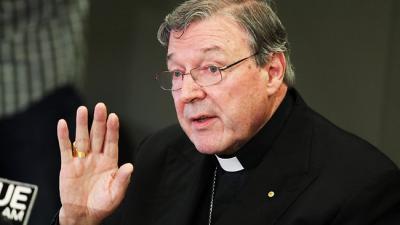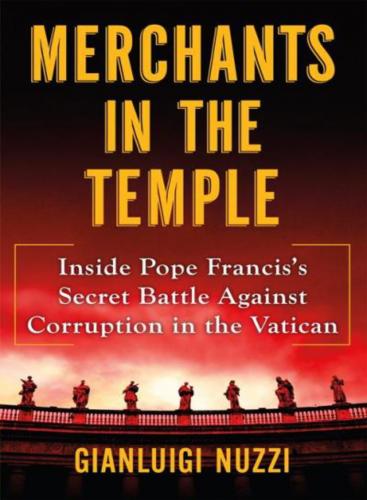Books: Reforming Vatican reformers

ROME -- Preventing further Vatican financial scandals was a key motive in the election of Pope Francis in March 2013. He appointed a Commission, whose acronym was COSEA, to investigate Vatican finance and administration. Nine months later, after thoroughly irritating Vatican bureaucrats, COSEA wound up its work with a report which identified mistaken investments, contracts for cronies, an ever-mounting debt for Vatican Radio, irregularities in places such as the Vatican supermarket, use of worldwide offerings for the Pope’s charities to cover Vatican shortfalls, excessive charges in saint-making procedures, an ominous future for Vatican pension funds and huge apartments assigned to cardinals. Cardinals have always occupied them but now the contrast with the pope’s two-room digs is striking.
Sections of this report, which were leaked to the Italian journalist Gianluigi Nuzzi, are the main basis for Merchants in the Temple.
Pope Francis’s predecessor, Benedict XVI, had stopped the Vatican being an off-shore financial refuge in central Rome by agreeing to stringent international controls to prevent money laundering but lacked the energy to overcome Curial resistance to reform. ( Moneyvals, the Council of Europe body which combats recycling, has just filed its second annual report which says that the Vatican has improved its controls against financial crime but needs to strengthen its relevant penal procedures. )
Francis brought in someone adjudged ideal for the pushing through the reform, Cardinal George Pell. Nuzzi uses a transcript of a fifteen- cardinal commission called , in March 2013,to approve the Vatican budget. Francis sprang a surprise by announcing he had established a Secretariat for the Economy under Pell.
Previously the Secretariat of State had been the major Vatican office but now Pell’s Secretariat was given equal status with equal access to the Pope. It had to act on the COSEA report.
Pell moved into turf already controlled by other cardinals. Vatican offices administered their own finances, some of them better than others, but none wanted a centralised control.
Nuzzi recounts some of the friction between the other cardinals and the ‘ambitious mastiff’ from Sydney. When Pell told the press that he had found substantial sums within the Secretariat of State, it thought he was grandstanding ; it responded that they were reserves for emergencies whose existence was known to every pope. Pell planned to set up a Vatican Asset Management which would pool all its finances to enable profitable investments ‘with exemplary transparency and efficiency’. So far nothing has been done about this body as Francis is wary of it. Pell has concentrated on introducing international -standard budgeting and accounting procedures.
Nuzzi does not give many details of what has been done to correct the defects
Identified by COSEA although he claims that not all dubious Vatican banking accounts have been closed as was announced. He makes it clear that the contest between Pell and the old guard cardinal, Domenico Calcagno, head of the Vatican central bank APSA, so far is a draw. (Calcagno is nicknamed Cardinal Rambo because he collects arms). Nuzzi repeats the claim made by another Italian journalist that Pell went on a spending spree, running through 500,000 euro in his first six months. Pell has replied that the figure is 292,000 euro and included setting up an office and the chapel within it. Two key prelates came out in his defence.
Nuzzi has interesting documents but his interpretation, that Francis and his mastiff are fighting reactionaries who have slowed things down (it took 16 months to appoint an Auditor General) but should eventually win out, is plausible although a bit simplistic.
Friction has occurred between Pell and another of the new guard, Cardinal Paolo Parolin, the Secretary of State, others find Pell brusque and he has not been able to do all he thought necessary. Nuzzi is meticulous but could have asked whether the reform is not well- tuned and some those involved are inadequate.
Three of these are the secretary of COSEA, a Spaniard Monsignor Vallejo Balda, and two of its other members who are being tried in the Vatican along with, inexplicably, Nuzzi and another Italian journalist to whom they allegedly leaked documents. For Nuzzi the trio leaked the documents to let truth emerge but others claim it was because they were miffed when not promoted to Pell’s Secretariat. One of the COSEA members was an Italian-Maroccan PR, Francesca Immacolata Chaouqui, who has engaged in mutual recriminations with Balda, and has probably set the cause of lay women in the Vatican back by some centuries. Rarely a day passes without her giving interviews with statements such as ‘ Roman Curialists won’t accept that a group of Australian police, who get exorbitant salaries, comes into their house and calls them all thieves.” The Australian police are Pell and the manager he brought with him from Sydney, Danny Casey.
Both Balda and Chaouqui were appointed under Francis and it was under Francis that the regulation was introduced by which they and the journalists were tried. Nuzzi does not give sufficient consideration to the possibility that the reform itself needs some reforming.
Merchants in the Temple Gianluigi Nuzzi Holt-Macmillan.(US Price $28)ch-do'g



